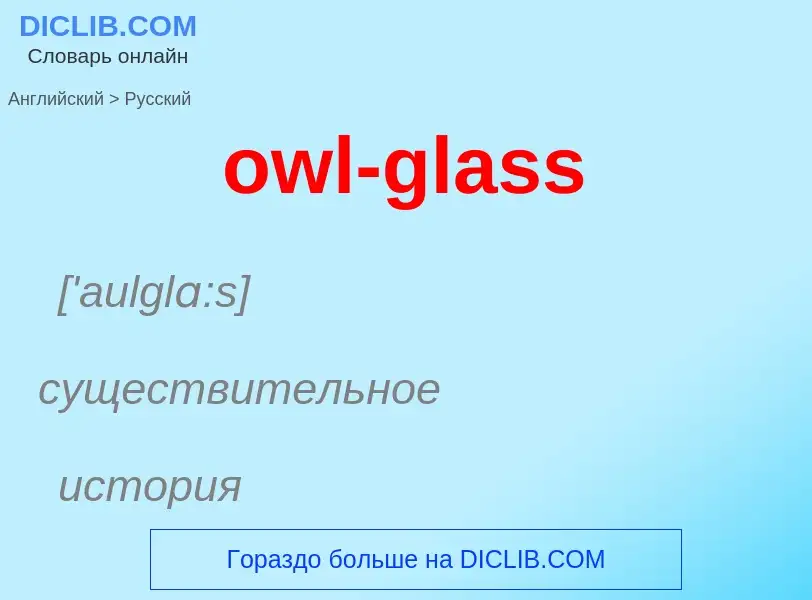Tradução e análise de palavras por inteligência artificial ChatGPT
Nesta página você pode obter uma análise detalhada de uma palavra ou frase, produzida usando a melhor tecnologia de inteligência artificial até o momento:
- como a palavra é usada
- frequência de uso
- é usado com mais frequência na fala oral ou escrita
- opções de tradução de palavras
- exemplos de uso (várias frases com tradução)
- etimologia
owl-glass - tradução para russo
['aulglɑ:s]
существительное
история
шут
[aul]
общая лексика
сова
совы (Strigiformes)
существительное
[aul]
общая лексика
глупец
чванливый дурак
полуночник
олух
зоология
сова
сыч
филин (Strigiformes)
глагол
общая лексика
бродить в темноте
диалектизм
вести ночной образ жизни
общая лексика
Object Windows Library
библиотека объектов Windows, библиотека OWL
библиотека фрагментов для прикладных программ. Входит в Borland C++ 4.5
Definição
Wikipédia

Glass fiber (or glass fibre) is a material consisting of numerous extremely fine fibers of glass.
Glassmakers throughout history have experimented with glass fibers, but mass manufacture of glass fiber was only made possible with the invention of finer machine tooling. In 1893, Edward Drummond Libbey exhibited a dress at the World's Columbian Exposition incorporating glass fibers with the diameter and texture of silk fibers. Glass fibers can also occur naturally, as Pele's hair.
Glass wool, which is one product called "fiberglass" today, was invented some time between 1932 to 1933 by Games Slayter of Owens-Illinois, as a material to be used as thermal building insulation. It is marketed under the trade name Fiberglas, which has become a genericized trademark. Glass fiber when used as a thermal insulating material is specially manufactured with a bonding agent to trap many small air cells, resulting in the characteristically air-filled low-density "glass wool" family of products.
Glass fiber has roughly comparable mechanical properties to other fibers such as polymers and carbon fiber. Although not as rigid as carbon fiber, it is much cheaper and significantly less brittle when used in composites. Glass fiber reinforced composites are used in marine industry and piping industries because of good environmental resistance, better damage tolerance for impact loading, high specific strength and stiffness.



![[[Burrowing owl]] (''Athene cunicularia'') [[Burrowing owl]] (''Athene cunicularia'')](https://commons.wikimedia.org/wiki/Special:FilePath/Athene cuniculariaa.jpg?width=200)
 Male.jpg?width=200)





![The [[serration]]s on the leading edge of an owl's flight [[feather]]s reduce noise The [[serration]]s on the leading edge of an owl's flight [[feather]]s reduce noise](https://commons.wikimedia.org/wiki/Special:FilePath/EulenfederTeil3.jpg?width=200)
![Comparison of an owl (left) and hawk (right) [[remex]]. Comparison of an owl (left) and hawk (right) [[remex]].](https://commons.wikimedia.org/wiki/Special:FilePath/Feathers owl vs hawk.png?width=200)

![A [[great horned owl]] with wet [[feathers]], waiting out a [[rainstorm]] A [[great horned owl]] with wet [[feathers]], waiting out a [[rainstorm]]](https://commons.wikimedia.org/wiki/Special:FilePath/Great Horned Owl in a Rain Storm in the Mojave.jpg?width=200)
![The [[snowy owl]] has effective [[snow camouflage]] The [[snowy owl]] has effective [[snow camouflage]]](https://commons.wikimedia.org/wiki/Special:FilePath/Harfang en vol 1.jpg?width=200)

![The [[laughing owl]] (''Ninox albifacies''), last seen in 1914 The [[laughing owl]] (''Ninox albifacies''), last seen in 1914](https://commons.wikimedia.org/wiki/Special:FilePath/Keulemans Laughing Owl.jpg?width=200)

![A [[great horned owl]] (''Bubo virginianus'') sleeping during daytime in a hollow tree A [[great horned owl]] (''Bubo virginianus'') sleeping during daytime in a hollow tree](https://commons.wikimedia.org/wiki/Special:FilePath/Owl sleeping in tree.jpg?width=200)
![A purpose-built owl-house or owlery at a farm near [[Morton on the Hill]], England (2006) A purpose-built owl-house or owlery at a farm near [[Morton on the Hill]], England (2006)](https://commons.wikimedia.org/wiki/Special:FilePath/Owlery at Morton on the Hill - geograph.org.uk - 532355.jpg?width=200)

![Owl eyes each have [[nictitating membrane]]s that can move independently of each other, as seen on this [[spotted eagle-owl]] in [[Johannesburg]], [[South Africa]]. Owl eyes each have [[nictitating membrane]]s that can move independently of each other, as seen on this [[spotted eagle-owl]] in [[Johannesburg]], [[South Africa]].](https://commons.wikimedia.org/wiki/Special:FilePath/SpottedEagleOwl2539MGEyeLid.jpg?width=200)

![A [[long-eared owl]] (''Asio otus'') in an erect pose A [[long-eared owl]] (''Asio otus'') in an erect pose](https://commons.wikimedia.org/wiki/Special:FilePath/Waldohreule (Asio otus) Pfahlhaltung.jpg?width=200)
![An owl-shaped protocorinthian [[aryballos]], c. 640 BCE, from Greece An owl-shaped protocorinthian [[aryballos]], c. 640 BCE, from Greece](https://commons.wikimedia.org/wiki/Special:FilePath/Aryballos owl Louvre CA1737.jpg?width=200)
![A Roman owl mosaic from [[Italica]], Spain A Roman owl mosaic from [[Italica]], Spain](https://commons.wikimedia.org/wiki/Special:FilePath/Itálica Owl.jpg?width=200)
![A [[Manises]] plate, c. 1535. A fantastical owl wearing a crown, a characteristic Manises design during the first half of the 16th century A [[Manises]] plate, c. 1535. A fantastical owl wearing a crown, a characteristic Manises design during the first half of the 16th century](https://commons.wikimedia.org/wiki/Special:FilePath/Hispano-Moresque - Plate - Walters 481099.jpg?width=200)
![''The Little Owl'', 1506, by [[Albrecht Dürer]] ''The Little Owl'', 1506, by [[Albrecht Dürer]]](https://commons.wikimedia.org/wiki/Special:FilePath/Albrecht Dürer - The Little Owl - WGA7367.jpg?width=200)
![Wooden Owls of Natungram]], [[West Bengal]], India. The wooden owl is an integral part of an ancient and indigenous tradition and art form in Bengal along with its auspicious association with Goddess of wealth, Laxmi. Wooden Owls of Natungram]], [[West Bengal]], India. The wooden owl is an integral part of an ancient and indigenous tradition and art form in Bengal along with its auspicious association with Goddess of wealth, Laxmi.](https://commons.wikimedia.org/wiki/Special:FilePath/Natungram Dolls, West Bengal.jpg?width=200)
